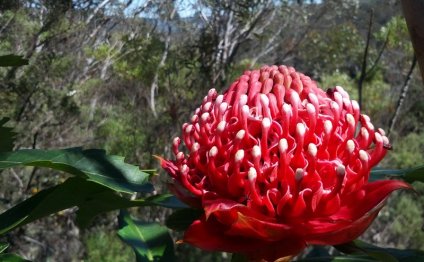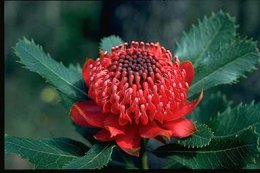
New South Wales Flowers
 (plant household: Proteaceae)
(plant household: Proteaceae)
Floral Emblem of New South Wales
Telopea speciosissima, ended up being proclaimed the official flowery emblem of the latest South Wales on 24 October 1962. Robert Brown (1773-1858) known as the genus Telopea in 1810 from specimens gathered within the Blue Mountains, west of Sydney. Sir James Smith (1759-1828), a noted botanist and founder for the Linnaean Society in The united kingdomt, had written in 1793:
'the absolute most magnificent plant that the respected earth of the latest Holland affords is, by common permission, each of Europeans and Natives, the Waratah. Its more over a popular aided by the latter, upon account of a rich honeyed liquid which they sip from its plants'.
The common name Telopea hails from the Greek 'telopos', indicating 'seen from afar', and is the long way from where the crimson flowers tend to be discernible. The particular name speciosissima could be the superlative for the Latin adjective 'speciosus', indicating 'beautiful' or 'handsome'. 'Waratah', the Aboriginal title the species, was followed by early settlers at Port Jackson.
Telopea is an eastern Australian genus of four species. Two are confined to brand new Southern Wales, anyone to Tasmania plus one extends from eastern Victoria into New South Wales. Telopea is one of the family, Proteaceae, which can be predominantly Australian and southern African in circulation and includes genera such as for example Grevillea, Banksia, Macadamia and Hakea. Protea cynaroides, King Protea, is the formal flowery emblem associated with the Republic of Southern Africa.
The Waratah is a stout, erect shrub that may grow to 4 metres. The dark-green leathery leaves, 13-25 cm long, tend to be organized alternatively and are generally coarsely toothed. The blossoms tend to be grouped in rounded minds 7 to 10 cm in diameter in the middle of crimson bracts, about 5 to 7 cm very long. It blossoms from September to November and nectar-seeking wild birds act as pollinators. Large winged seeds tend to be released if the brown leathery pods split along one part.
The species is pretty widespread from the main coastline and adjoining hills of New South Wales, happening through the Gibraltar Range, north of Sydney, to Conjola when you look at the south. It grows mainly into the shrub understorey in open forest developed on sandstone and adjoining volcanic structures, from sea-level to above 1000 metres in Blue Mountains. Grounds within its range are generally sandy and lower in plant nutrients. Rainfall is mildly high. Waratah plants resist destruction by bushfires, a normal element of their habitat, by regenerating through the rootstock. Flowering recommences 2 yrs after a moderate fire.
The Waratah is an amazing yard topic in appropriate soil and environment; it flowers prolifically and is often long-lived. Failures usually can be caused by the effects of improper earth circumstances, aspect or weather. Seeds must be sown in a coarse sandy method and soon after germination the seedlings ought to be transplanted into specific pots of similar soil. Fresh seeds germinate readily although seedlings are prone to the fungal condition, 'damping off', which might be paid off by revealing the seedlings to complete light, except for the shading needed after transplanting. Propagation by cuttings can also be feasible. Inside garden, flowers should always be cultivated in gently shaded to sunny opportunities in deep, well-drained earth. They should be well-watered until fully established but waterlogging must be averted.
The Waratah reacts really to pruning which motivates flowering the next year, and overcomes the natural tendency of this shrub to believe a straggly form. Some pruning is achieved by cutting blossoms for decoration. It's a spectacular cut flower and lasts well in water.
Flowers are often crimson, but an uncommon creamy white type, Telopea 'Wirrimbirra White', has been continuously grown effectively as a horticultural interest. Manipulated hybrids of T. speciosissima have now been produced incorporating the brilliance of their blossoms using higher frost tolerance of various other Telopea species. Hybrids between T. speciosissima and Braidwood Waratah, T. mongaensis, have smaller plants but are often much more floriferous with a tight form and attractive foliage. One of these brilliant hybrids could be the authorized cultivar, Telopea 'Braidwood Brilliant', a magnificent yard plant created within Australian nationwide Botanic Gardens.
The Waratah happens normally in at the very least ten national areas inside geological formation, know since the Sydney Basin. Brisbane liquid, Dharug and Macquarie Pass National Parks tend to be among the list of places where this species is conserved. Waratahs are cultivated north of Sydney and in the Dandenong Ranges, Victoria. These are typically grown in Israel, New Zealand and Hawaii when it comes to slice rose trade. It was introduced to The united kingdomt in 1789 but cannot endure English winters outside except within the south-west coastal regions, therefore seldom flowers in glasshouses. Furthermore developed in Ca.
As soon as the Australian flora started initially to affect designers and craftsmen of European beginning, the Waratah ended up being followed as a motif. The Museum of Applied Arts and Sciences in Sydney has actually a substantial collection of arts and crafts featuring styles in line with the Waratah. The diversity of news utilized in the collection consist of suede, stained glass, bone tissue china and earthenware, glassware, copper, bronze, and lumber. In 1915, R. T. Baker, a separate recommend associated with the waratah (and other local flora) as a motif in art, craft and industry, penned:
- 'The entire plant (waratah) lends itself to such a boldness of imaginative some ideas in every branches of used Art it has actually couple of compeers amongst the representatives for the whole floral world...'
Many governing bodies and neighborhood teams in brand new South Wales utilize the Waratah within their insignia, usually adopting a stylised version of the flowerhead. It absolutely was portrayed in the 3 shilling stamp [illust], among a set granted in 1959 illustrating Australian flora. Margaret Stones, an Australian botanical singer then attached to the staff of Kew Gardens, London, designed the stamp. The Waratah was used again from the 30 cent stamp [illust] within a State flowery emblem put released on 10 July 1968.
Share this Post
Related posts
Nambucca Heads, New South Wales
Thank you for visiting Eyecare Plus Optometrist Nambucca Heads Local optometrist Eyecare Plus Nambucca Heads target comprehensive…
Read MoreSydney New South Wales Australia weather
A slow-moving storm has actually hammered components of eastern Australia s New South Wales province with damaging winds…
Read More










